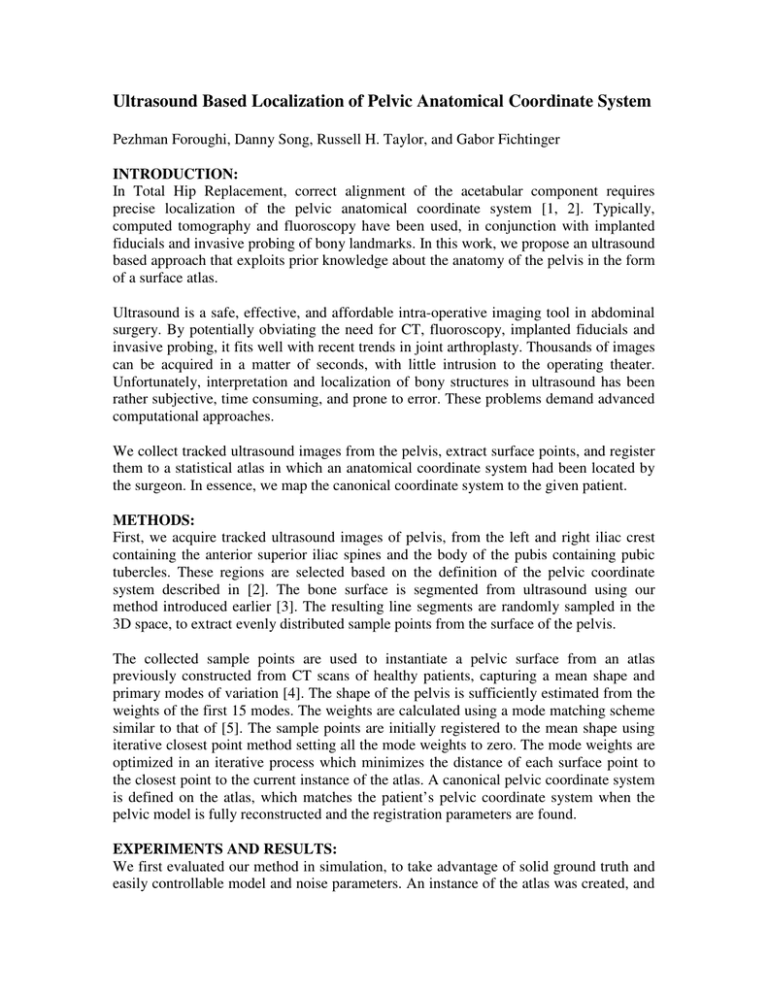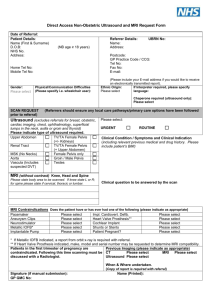Ultrasound Based Localization of Pelvic Anatomical Coordinate System
advertisement

Ultrasound Based Localization of Pelvic Anatomical Coordinate System Pezhman Foroughi, Danny Song, Russell H. Taylor, and Gabor Fichtinger INTRODUCTION: In Total Hip Replacement, correct alignment of the acetabular component requires precise localization of the pelvic anatomical coordinate system [1, 2]. Typically, computed tomography and fluoroscopy have been used, in conjunction with implanted fiducials and invasive probing of bony landmarks. In this work, we propose an ultrasound based approach that exploits prior knowledge about the anatomy of the pelvis in the form of a surface atlas. Ultrasound is a safe, effective, and affordable intra-operative imaging tool in abdominal surgery. By potentially obviating the need for CT, fluoroscopy, implanted fiducials and invasive probing, it fits well with recent trends in joint arthroplasty. Thousands of images can be acquired in a matter of seconds, with little intrusion to the operating theater. Unfortunately, interpretation and localization of bony structures in ultrasound has been rather subjective, time consuming, and prone to error. These problems demand advanced computational approaches. We collect tracked ultrasound images from the pelvis, extract surface points, and register them to a statistical atlas in which an anatomical coordinate system had been located by the surgeon. In essence, we map the canonical coordinate system to the given patient. METHODS: First, we acquire tracked ultrasound images of pelvis, from the left and right iliac crest containing the anterior superior iliac spines and the body of the pubis containing pubic tubercles. These regions are selected based on the definition of the pelvic coordinate system described in [2]. The bone surface is segmented from ultrasound using our method introduced earlier [3]. The resulting line segments are randomly sampled in the 3D space, to extract evenly distributed sample points from the surface of the pelvis. The collected sample points are used to instantiate a pelvic surface from an atlas previously constructed from CT scans of healthy patients, capturing a mean shape and primary modes of variation [4]. The shape of the pelvis is sufficiently estimated from the weights of the first 15 modes. The weights are calculated using a mode matching scheme similar to that of [5]. The sample points are initially registered to the mean shape using iterative closest point method setting all the mode weights to zero. The mode weights are optimized in an iterative process which minimizes the distance of each surface point to the closest point to the current instance of the atlas. A canonical pelvic coordinate system is defined on the atlas, which matches the patient’s pelvic coordinate system when the pelvic model is fully reconstructed and the registration parameters are found. EXPERIMENTS AND RESULTS: We first evaluated our method in simulation, to take advantage of solid ground truth and easily controllable model and noise parameters. An instance of the atlas was created, and the surface of the model was sampled at the areas of interest. A randomly generated uniform noise of maximum 2 mm was then added to the three coordinates of each sample. Then a small random transformation was applied to the points with maximum rotation parameters of 5 degrees and maximum translation parameters of 5 mm. Our method was then used to reconstruct the pelvis and find the pelvic coordinate system. This experiment was repeated 100 times, yielding sub-mm and sub-degree accuracies reported in Table 1. We also conducted two cadaver experiments in realistic intra-operative scenario. We used a low-cost portable SonoSite ultrasound unit and Polaris optical tracking system (Northern digital Inc.) to collect approximately 500 tracked ultrasound images from the cadaver. Without moving the body, we also acquired a full pelvic CT scan with 1.5mm slice thickness. We registered the CT to the atlas as ground truth using [4] and registered the ultrasound to the atlas with our method. We compared the poses of two coordinate systems in Table 1. Table 1: Estimate errors of the measured anatomical coordinate system Error of anatomical coordinate system localization Experiment α (degrees) β (degrees) γ (degrees) x (mm) y (mm) Simulation 0.39 0.07 0.39 0.09 0.43 Cadaver 1 0.72 0.69 0.97 0.88 2.04 Cadaver 2 1.36 1.39 0.36 1.32 0.42 z (mm) 0.46 2.29 3.33 DISCUSSION: Our ultrasound based system localized the pelvic anatomical coordinate system with a clinically acceptable accuracy of 0.9 degree and 1.7 mm. As a precursor of our work, Chen et al. matched bone surface points in US to a statistical pelvis model with an accuracy of 3.7mm [6]. Our improvements over Chen’s results are attributed to statistical spreading of the US points, robust initialization of the optimization, and accurate bone segmentation. Ultrasound localization eliminates pre-operative CT, fiducials, and invasive probing. This approach seems applicable in procedures where atlas is readily available. The atlas is an effective source of prior knowledge about the anatomical structure of the bone. It helps compensate for missing data where the acquisition of ultrasound images is problematic due to physical access. Finally, defining the coordinate system on the atlas allows for direct derivation of patient specific frame of reference from the results of registration. REFERENCES: [1] M. Honl et al., “Orientation of the acetabular component: A COMPARISON OF FIVE NAVIGATION SYSTEMS WITH CONVENTIONAL SURGICAL TECHNIQUE”, Journal of Bone and Joint Surgery, Vol. 88-B(10), pp. 1401-1405, 2006 [2] C. Nikou et al., “Description of Anatomic Coordinate Systems and Rationale for Use in an Image-Guided Total Hip Replacement System”, in Medical Image Computing and Computer Assisted Intervention (MICCAI), pp. 1188–1194, 2000 [3] P. Foroughi et al., “Ultrasound bone segmentation using dynamic programming,” in IEEE Ultrasonics Symposium, pp. 2523–2526, 2007 [4] G. Chintalapani et al., “Statistical atlases of bone anatomy: Construction, iterative improvement and validation,” in Medical Image Computing and Computer Assisted Intervention (MICCAI), pp. 499–506, 2007 [5] T.F. Cootes, G.J. Edwards, and C.J. Taylor, “Active Appearance Models”, in Computer Vision — ECCV, pp. 484–498, 1998 [6] C.S.K. Chan et al., "Cadaver Validation of the Use of Ultrasound for 3D Model Instantiation of Bony Anatomy in Image Guided Orthopaedic Surgery", in Medical Image Computing and Computer Assisted Intervention (MICCAI), pp. 397-404, 2004



![Jiye Jin-2014[1].3.17](http://s2.studylib.net/store/data/005485437_1-38483f116d2f44a767f9ba4fa894c894-300x300.png)



